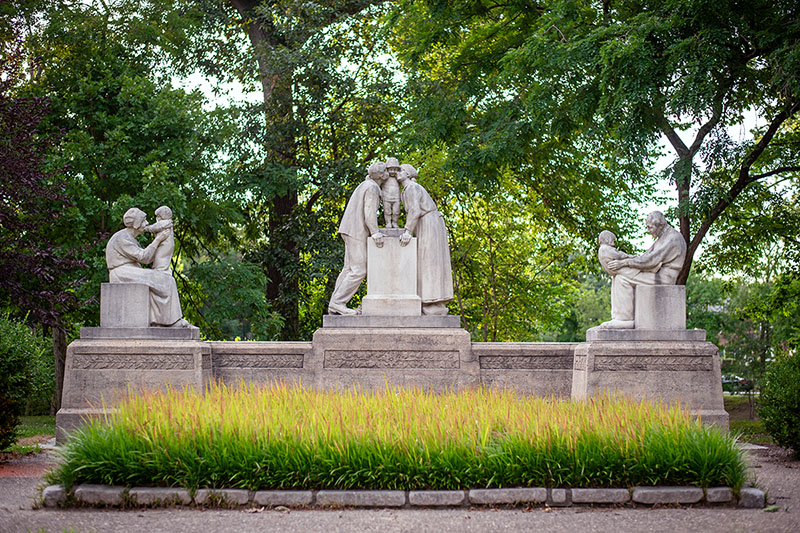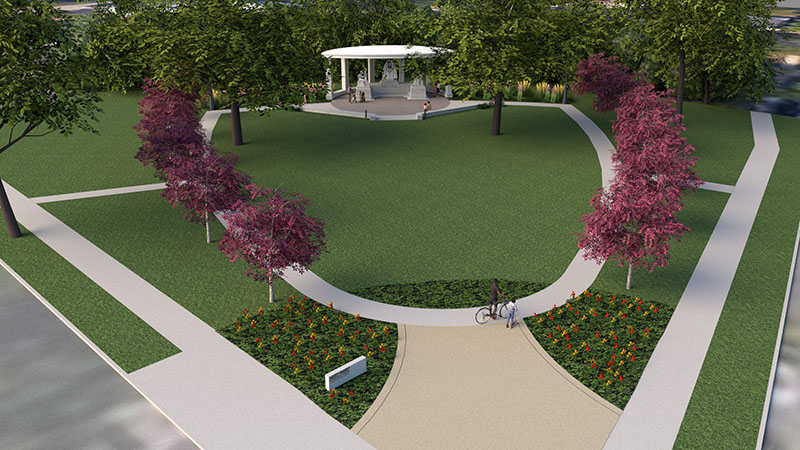
Why does our statuary need protecting?
Over the past 95 years, our Mariemont statues have endured a myriad of harsh environmental conditions—soot from the steam engines at the railroad below Miami Bluff, acid rain, mildew, and, particularly detrimental to the Statuary, the rain/freeze/thaw conditions that we experience in this area. The fine carvings of the statues have slowly eroded and will continue to do so.
Mariemont Preservation Foundation (MPF) has had the preservation of this Statuary on its radar for many years as it is showing signs of deterioration. After much consultation with experts in limestone carvings, MPF was advised that the only way to truly preserve this historic piece of art would be to provide a shelter to protect it from the elements.
The French Sculpture Organization has no knowledge of any other life-sized carvings by Alliot which makes this statuary historically unique. The French Heritage Society has referred to this grouping of statues as a “treasure” deserving of proper care and has commended MPF on their efforts to preserve this Statuary for the enjoyment of future generations.
Mary Emery never lived to see the statues in place as she had intended, however, they are a daily reminder of her social commitment to better the lives of families, especially children. They are emblematic of the high quality of life in Mariemont.
As stewards of Mariemont’s historical integrity, MPF is leading the charge to ensure this project comes to fruition.
The construction of an appropriately sized protective structure is a major undertaking. Both the building of the shelter and the rehabilitation of the park are estimated to cost as much as $900,000.
We hope you will join us in this important pursuit.
What does the project entail?
This project consists of two parts: building a shelter to protect the Family Statuary, and rehabilitating the landscaping of the park around the Statuary, called Dale Park Gardens.

Family Statuary Shelter
- Minimalistic, semi-elliptical shape allows unimpeded views of statues from all angles
- Statues are carefully centered between natural limestone columns
- Design complements adjacent architecture: Italian Renaissance, Georgian, and Colonial
- Design utilizes limestone, stucco, and red brick apron
- ADA accessibility around the statuary

Dale Park Gardens Landscaping
- Update the landscaping around the Statuary
- Showcase the Family Statuary in a more enhanced setting
- Provide a welcoming space for residents and visitors
- Highlight the entrance to our Historic District
What is the history of our Family Statuary?
In the early 1920s, Mary Emery became aware of the existence of a life-size model of a statuary group made for the City of Paris by French sculptor Lucien Charles Eduard Alliott (1877-1967). It was named “A L’Enfance” (Translation: To Childhood) and consisted of three related groups: a peasant Father and Mother standing with a child between them; a Grandmother and Grandbaby; and a Grandfather and Grandchild. A miniature of this statuary group had been exhibited at the Paris Salon in 1920 where it won a gold medal. It was its name and the depiction of family members doting over the children that appealed to Mary Emery who wanted it to be placed in Dale Park Gardens.
She dispatched her business advisor and friend, Charles Livingood, to Paris to commission a carving. In contracting for this carving, Livingood was informed that it would be a replica, as an original was intended to be carved for the City of Paris. Hence, the description on the back of the central figures, ”L’original de ce monument apparient a Ville de Paris.” (Translation: The original of this monument belongs to the City of Paris). However, according to Livingood, the City of Paris never ordered the making of this statuary group so it would appear the Mariemont “replica” is the only one sculpted, which according to the French Sculpture Organization makes it unique and possibly more valuable.
The individual statues were to be mounted on a substantial foundation with the parents and child in the center. A detailed drawing (in metric measurements) was sent to the Resident Architect Charles Cellarius and the Resident Engineer Warren Parks so that they could supervise the building of the base. Every effort was made to, as nearly as possible, prepare the concrete to match the French limestone from which the statures were carved. Experiments were made using various combinations of cement, yellow sand, and marble chips until a satisfactory mix resulted. The pre-mixed concrete was hauled from a plant in Cincinnati then poured and cured. After which, the base was bush-hammered to give it texture, and a special pre-cast decorative concrete panel was placed upon the top of the base.
The base was completed in time for the statues’ arrival which came in three large crates and had to be placed using a large crane. Their unveiling was on the same day as the dedication of the Carillon, November 16, 1929.
Last modified: August 25, 2024
